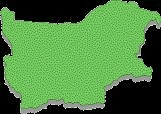|
Plovdiv region |
|
||||||
|
The area of Plovdiv region is 13,585 sq. km (12.2% of the territory of the country). To the north the boundary follows the ridge of Balkan Range and includes part of the sub-Balkan valleys (Karlovo). The vast and fertile Upper Thrachian Plain is in the central part of Plovdiv region. The south includes part of the Rhodope Mountains. The climate and the fertile soils of the Upper Thrachian Plain are very suitable for intensive farming. The region is
crossed by the Maritsa, one of the biggest Bulgarian rivers. Hisarya, Velingrad, Devin and Banya are spas. Plovdiv has an important transport function in South Bulgaria. The high speed motorway Trakiya and convenient railway transport connect Plovdiv and Sofia. Tourism is a priority of the region. The high mountain resort Pamporovo (near Smolyan ) is internationally famous. Health tourism is also developing in Hisarya, Narechen and Devin. Plovdiv is a successor of an old Thrachian town. It is beautifully located on seven hills. Valuable surviving architecture monuments have been exposed. An ancient amphitheatre in the central part of the city town, part of the ancient water supply system. Valuable architectural monuments (the ethnographical museum), the houses of prominent artists (Zlatyu Boyadzhiev, Tsanko Lavrenov), old streets that used to form the center of the old town have been preserved and restored. Modern Plovdiv is the second largest city in Bulgaria (341,000) and an important cultural center. Traditional is the international annual fair, held in May and in September. A free trade zone on the fair grounds facilitates the international economic links. Plovdiv is an academic center with a University, a Medical Institute and an Agricultural institute. The towns Sopot, Karlovo and Kalofer that are connected with Bulgarian Revival are in the northern part of the region. Today they work for the national military industrial complex. To the south, inSmolyan , Madan and Rudozem, have preserved the typical architecture of the Rodope Mountains. Many tourists visit the fortress near Asenovgrad, the Bachkovo Monastery, the interesting natural history museum inChepelare , the architectural complex in the village of Mogilitsa (near Smolyan) the astronomy observatory at Rozhen (near Smolyan). |
|||||||
|
|
|||||||
